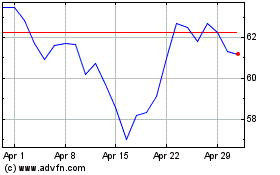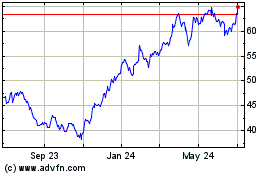FedEx Corp. is raising its fuel surcharge for the second time
this year, jolting e-commerce companies, retailers and other
shippers with price increases just as they gear up for the
make-or-break holiday sales season.
The increase, which takes effect Nov. 2, would add about $170 to
the bill for shipping 100 shoeboxes overnight from New York to
Atlanta, up from the $67 added by the current surcharge. The
figures, from an analysis by supply-chain consulting firm Spend
Management Experts, are based on FedEx's published rates and the
August average fuel price.
The package-delivery company previously boosted its
fuel-surcharge index in February, following a similar increase by
rival United Parcel Service Inc. Their indexes determine how much
the price of shipping a package will rise as fuel prices
fluctuate.
UPS's surcharge would add about $200 to the cost of shipping the
same 100 shoeboxes, the analysis found.
FedEx's latest increase caught customers off guard because the
company's fuel costs have been falling. The price of diesel fuel,
which FedEx uses in its trucks, has plunged by about a third over
the past year.
Spot prices for jet kerosene, which power FedEx's airplanes,
have fallen by nearly half to about $1.37 a gallon, according to
the U.S. Energy Information Administration.
The company says its latest increase is in response to heavier
packages and a rise in residential deliveries, which use up more
fuel.
Both FedEx and UPS reported that fuel costs were down about 35%
from the year earlier in their most recent quarter. While some
companies use the futures market to hedge their fuel costs, the two
delivery companies buy most of their fuel at near market
prices.
FedEx disclosed its latest surcharge-index increase without
fanfare on its website late last month, and it hasn't been
popular.
"There's no justification for it, because there's just no
explaining it, other than they're paying a whole heck of a lot less
for fuel, and they don't want to pass any fuel savings along to
their customers," said John Haber, chief executive of Spend
Management Experts.
"It's frustrating," said Sara Henderson, founder of e-commerce
startup BOGO Bowl, which ships as many as 30 packages of 20- to
60-pound bags of pet food each week, primarily via UPS.
"They give you discounts for being a regular shipper, but they
seem to make it up in others ways by putting all these little fees
here and there," she said.
For BOGO Bowl, like other companies that offer free shipping,
every penny counts. It builds shipping costs into the prices it
charges customers, so unanticipated increases eat into its
margins.
FedEx and UPS have been scrambling to boost their profits as
their customers shift to email for sending urgent documents,
instead of paying a premium to overnight them. Though e-commerce
has taken off, margins on that business are narrower because of the
higher costs of making deliveries to scattered homes.
The two companies have been raising prices to cover these costs,
charging by package size, instead of weight alone, and raising fees
for giant packages.
A FedEx spokesman attributed the surcharge boost to increasing
demand for residential deliveries and heavier packages, both of
which boost fuel consumption. "These trends have been accelerating
during the past year," the spokesman said.
A UPS spokeswoman said in an email that the company "maintains a
[fuel surcharge] level necessary to reduce price volatility and
ensure that revenue is properly aligned with our cost of service."
She said fuel surcharges themselves have been on a downtrend, even
with the change in UPS's fuel-surcharge index.
Shipping is one of the biggest costs for eCreamery Ice Cream
& Gelato, which ships customized frozen treats. While the
company has been able to negotiate some shipping discounts, the
fuel surcharge has never been open for discussion. "Shipping is one
of our biggest line items, and is hard to pass on to the customer,"
said Abby Jordan, eCreamery's co-founder.
As fuel prices rose between 2007 and 2013, both UPS and FedEx
cut their fuel surcharges, instead incorporating the costs into
their base rates. Both companies typically raise rates an average
of about 5% annually.
This year, the companies separated their fuel-surcharge-index
changes from their base rate increases, so most shippers who have
negotiated discounts won't be immune to the increases.
Consultants who work with shipping customers say most of them
have yet to notice the quiet change in FedEx's fuel-surcharge
index, and they worry about the precedent it sets.
"It's a bad sign for shippers across the board. If the market is
going to bear a fuel surcharge increase when fuel's at its lowest
levels in years, what's next?" said Brian Litchfield, executive
director of Transpend Solutions, which helps shippers manage
transportation expenses.
Write to Laura Stevens at laura.stevens@wsj.com
Access Investor Kit for "CitiGroup Inc"
Visit
http://www.companyspotlight.com/partner?cp_code=P479&isin=US1729674242
Subscribe to WSJ: http://online.wsj.com?mod=djnwires
(END) Dow Jones Newswires
October 05, 2015 20:55 ET (00:55 GMT)
Copyright (c) 2015 Dow Jones & Company, Inc.
Citigroup (NYSE:C)
Historical Stock Chart
From Mar 2024 to Apr 2024

Citigroup (NYSE:C)
Historical Stock Chart
From Apr 2023 to Apr 2024
